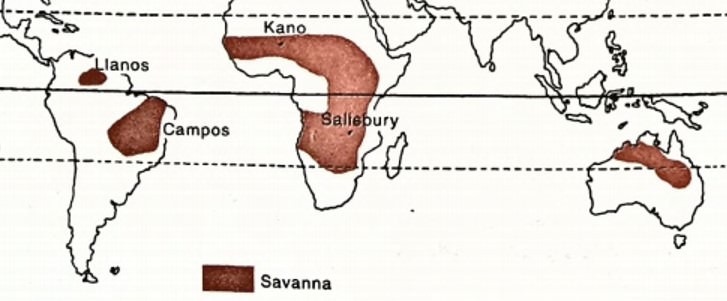Introduction:
Savanna regions encompass two distinct seasons, marked by a wet season characterized by abundant rainfall and a dry season with minimal precipitation. This climatic dichotomy influences the vegetation, resulting in the growth of lush green grasses and wooded areas during the wet season.
Main Body:

Savanna Biomes:
- Savannas, often referred to as tropical grasslands, are predominantly situated to the north and south of tropical rainforest biomes.
- The most extensive savanna regions can be found in Africa, where countries like Kenya and Tanzania encompass substantial tropical grasslands.
- Beyond Africa, savanna grasslands also make their presence known in Brazil, South America.
Distribution of Savanna:
- The Savanna climate is typically situated between the latitudes of 10° to 20° on both sides of the equator.
- It serves as a transitional climate, bridging the gap between equatorial rainforests and hot desert regions.
- Its location is defined by the shifting pressure belts, residing between the equatorial low-pressure belt associated with the Intertropical Convergence Zone (ITCZ) and the subtropical high-pressure belt.
Seasonal variations in the sun’s position lead to dynamic changes:
- During the summer solstice (21 June), the northward migration of the sun shifts the equatorial low-pressure belt and ITCZ northward, ushering in atmospheric disturbances like cyclones that bring rains to the Savanna climate.
- Conversely, the southward migration of the sun during the winter solstice (23 December) places the Savanna climate under the influence of the subtropical high-pressure belt, resulting in anticyclonic conditions and dry weather.
- The descending stable winds during anticyclonic conditions contribute to the arid nature of the dry season.
Wind patterns also play a pivotal role:
- Onshore winds during summer deliver precipitation, while offshore winds in winter maintain dry conditions.
- The prevailing Trade Winds, strengthened during the summer, bring rainfall to coastal regions but tend to be drier as they advance inland or approach western coasts.
- Local winds and sea breezes further impact coastal areas.
- Eastern coastal areas are influenced by trade winds, and the warm season often witnesses the dominance of strong and high-velocity tropical cyclones.
Conclusion:
Given its distinctive climatic conditions, the Savanna is renowned as natural cattle country, and many indigenous populations in these regions adopt pastoralism as a way of life.
This interplay of climatic factors in the formation of Savanna climates underscores the intricate relationship between environmental conditions and human livelihoods in these regions
